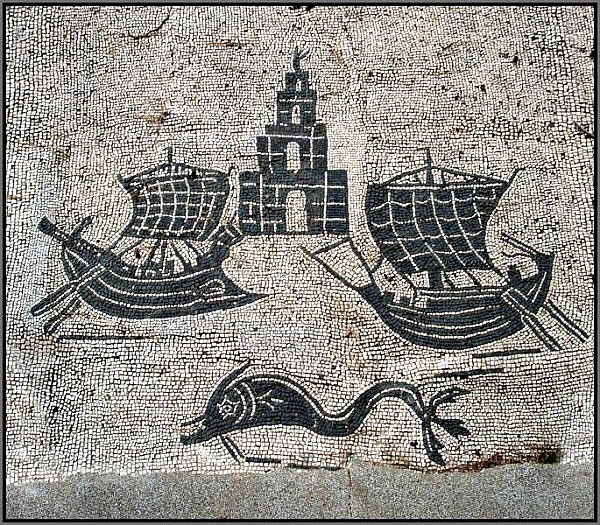Archaeologists tell the ports of Rome

Until next May 13 at the Teatro Argentina in Rome will be held the program of meetings "Luci sull'Archeologia 2018" for fans of archeology and history of Rome. With the guidance of the major Italian scholars will be revisited the most famous aspects of Roman history and civilization and the lesser known that the discoveries of archeology have unveiled.
In February a meeting was dedicated to the ports of Rome: from Ostia, the first port at the Tiber mouth, where all the goods destined to the Urbe arrived from the Republican age, to Puteoli (Pozzuoli) the great port that was the largest port of the Mediterranean in the age imperial, finishing to Classe, the port of late imperial age in the service of Ravenna that Honorius had elevated to the new capital of the Empire.
The commercial history of Rome is the history of its ports and in the period of greatest splendor from the age of Augustus to the third century it was its "door wide open on the Mediterranean" and when Rome became the owner of the "Mare Nostrum" and favored the institution of the free port of Delos, the Campanian port became the terminal of all trade. On its docks the precious goods coming from the east were unloaded, even from the furthest ports of Arabia and India, and the wealth that brought the commercial activity also led the Roman patricians to do business with the merchants. Pompey, Caesar and Cicero were in business with the leading bankers of Puteoli and because the law did not allow him to carry out business activities, were their freedmen who went in distant ports to find the most valuable goods, silk, linen, precious stones, pearls, marbles. purple and blue Egyptian and then resell them in Rome.
In the bay could enter large cargo ships capable of loads up to 450 tons and these were generally conducted by Greek or Syriac commanders (heirs of the Phoenicians); after the berth the goods were unloaded from the merchant's slaves, who brought them to the great horrea (warehouses) that were close to the docks.
The merchants coming from Tire, from Alessandria and from other cities of Syria and Asia had their statio, warehouses and deposits in Puteoli. These merchants introduced their cults into the city and erected great temples to their gods. The most obvious evidence is the Serapeum that was erected in the main square of Puteoli, his Forum.
Puteoli was also a great port of exchange where the goods could also leave for other destinations of the empire.
The goods that were destined for consumption in the Italian peninsula were disembarked instead in Ostia and in Portus where the merchants specialized in the commerce of grain and other cereals, oil, wine and heads of fish - with which was produced the garum, the sauce preferred by the Romans -, were operating.
In the ports at the Tiber mouth the large ships could not enter and then were moored in front of the coast and the cargo transshipped on other smaller ships that could enter the Port of Claudius or in that one of Trajan and then from these through the channels enter in the Tiber that was traced with the technique of hauling, or pulled by animals but also by slaves who walked along the shore.
The destination of the ships was the Emporium, the district of Rome where all the deposits were located and where the goods were unloaded and sold.
The city of Ostia was born as a port city and the splendid isolation to which the historical events have forced its territory and the frequent flooding of the Tiber that have covered it, have also preserved a unique territorial continuum, second only to Pompeya.
When Constantine brought the capital of the Empire to Constantinople, the trades towards Rome gradually diminished and the cities of Puteoli, Portus and Ostia lost importance. If in Rome no more maintenance work was carried out on the banks of the river and dredging of the docks of the ports with the consequence that the navigability of the canals and landings were made difficult and transport decreased, instead the port of Puteoli in the fourth century began to sink by the effect of bradyseism and its was a slow decline that began with the shift of trade routes.A new port had been elected as the terminal of trade for the western Mediterranean sea, the port of Ravenna: Civitas Classis.
Classis was born from an idea by Agrippa, who in the aftermath of the grains naval victories that gave to Augustus the control over Mediterranean Saa, decided to split the imperial fleet; the Classis Praetoria Misenensis Pia Vindex would have its headquarters, with the task of controlling the western Mediterranean, in Miseno not far from Puteoli, while the Classis Praetoria Ravennatis Pia Vindex was stationed in Ravenna with the task of overseeing the Eastern Mediterranean.
But it was only in 402 that brought the capital to Ravenna, the Civitas Classis was born with a large port that could accommodate ships carrying goods and food for the new capital.
Despite the many attacks that Ravenna and the port of Classis suffered from the Longobards, during their long confrontation with the Byzantines, Civitas Classis, its docks and deposits remained active until 870 when the Saracen pirates arrived and sacked the territory and the city that the fearful inhabitants had abandoned.
by M.L. ©ALL RIGHTS RESERVED (Ed 1.0 - 20/02/2018)






